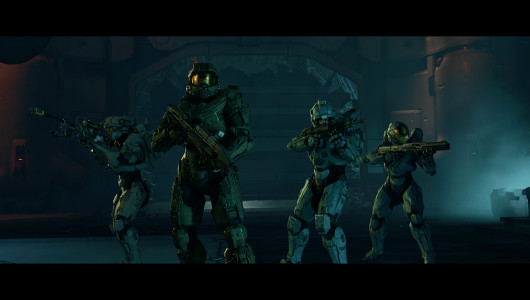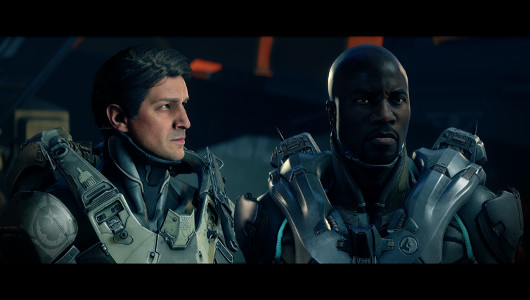Halo – as a series – could be regarded as the origin point of where the FPS genre began to find success on home consoles. It has broken ground many times before with the introduction of the matchmaking systems that we take for granted these days, a theatre mode to watch your previous matches and forge tools to create your own maps. Nearly 15 years after Halo: Combat Evolved was released we are now standing with Halo 5: Guardians in our hands, the second main series game to be helmed by developer 343 Industries.
After Halo 4, I was sceptical if 343 Industries were truly up to the task of helming such an iconic series, and even after playing Halo 5: Guardians for a considerable time that question still lingers in the back of my mind – although not nearly as prominently.
• Developer: 343 Industries
• Publisher: Microsoft Studios
• Reviewed on: Xbox One
• Release Date: Available Now
The campaign of Halo 5: Guardians takes place 18 months after the end of Halo 4 and sees you playing as not only the series main protagonist, Master Chief, but also as newcomer Spartan Jameson Locke. Locke is one of the new generation Spartan IV super soldiers and leads three other Spartans – Vale, Tanaka and Buck (who was last seen in Halo 3: ODST) – as a part of Fireteam Osiris.
Master Chief also heads up his own group of original Spartan II’s called Blue Team. Blue Team consists of Kelly, Frederic and Linda who – along with Master Chief – are some of the oldest Spartans still in deployment. Halo 5: Guardians marks their first appearance in the game series after being mentioned a considerable amount throughout the extended universe of books, live action series and more.
Halo 5: Guardians has these other Spartans consistently at your side in order to support drop in/drop out co-op gameplay with other players, which in itself is my first gripe with the campaign. Halo 5: Guardians doesn’t feel anywhere near as challenging as previous games in the series due to this. Having other NPC allies constantly at your side takes away from the storytelling element a considerable amount as well. Halo games have always been a distinctly personal story about one Spartan taking on the galaxy at large by himself, powering through enemies like they were made out of tissue paper. I never got that feeling once playing Halo 5: Guardians campaign, and on those rare occasions when I did die, my AI squad would simply revive me.
There’s no risk to the gameplay on higher difficulties such as Heroic and Legendary, no repercussions for making the wrong move, you’ll simply be revived on the fly.
There are only a handful of missions where you’ll actually be playing as the Master Chief alongside Blue Team, and these missions are screaming for some extended back story on who these Spartans are and where they come from given it’s their first appearance in game. There are small nuggets here and there that will cater to those of us who have invested in the lore of the extended universe, which is great, but for those players who haven’t, there’s so much story that is being missed out on.
That leaves us with Fireteam Osiris for the majority of the game who are definitely a mixed bag. Spartan Locke has the undeniable personality of a brick wall. He’s a boring character with very little of interest to say and who brings nothing to the table, he’s bland and generic. The same could be said for Tanaka, another Spartan in the group, until we get a brief nugget near the end of the campaign talking about her psyche. Spartan Vale is genuinely interesting with her ability to speak Sangheili (the Elites) and her respect for them. Buck makes his triumphant from Halo 3: ODST having been promoted from ODST to Spartan. Voiced by Nathan Fillion, he has some of the more memorable dialogue and interesting things to say throughout Halo 5: Guardians.
Another character who also returns in Halo 5: Guardians is the Arbiter, voiced by Keith David. Last seen in Halo 3, Arbiter heads up the Swords of Sanghelios, a group of Elites and other species, allied with humanity, who are attempting to destroy what is left of the Covenant. The few missions involving the Arbiter are some of the most interesting from a story perspective.
But a handful of decent missions alone aren’t enough, given the short running time of about 5/6 hours to complete the campaign. Looking at it as a whole, Halo 5: Guardians really feels like filler more than anything. There’s another Halo game coming, that much is for certain given the way the campaign ends. The story of Halo 5: Guardians leaves a lot to be desired, it’s executed in a very strange way, failing to introduce important characters to us and failing to fill in the blanks in places where it’s most important. It’s all over the place. There’s some great little bits of story in there for fans of the extended universe and the story is undoubtedly heading in an interesting direction. It’s simply a shame considering such a good job was done on Halo 4’s campaign and storytelling.
Moving on from campaign though is the multiplayer portion of the game. Halo 5: Guardians boasts an impressive multiplayer suite that is definitely catered to a more competitive audience or those of us who prefer a traditional Halo multiplayer experience. Overhauling the shambles that was Halo 4’s multiplayer – which was more than enough cause for concern, alongside The Master Chief Collection’s launch woes pre-empting Halo 5: Guardians – there are now two distinct variants of multiplayer to choose from – Arena and Warzone. One of the big changes that is instantly noticeable is that armour abilities from Halo: Reach and Halo 4 are no more and have been redesigned as Spartan abilities. These include thrusters for additional movement, a ground pound, a Spartan charge/ram and smart linked scopes on every weapon. These are all available by default for every player so nobody has to pick and choose between them, levelling the playing field.
Arena focuses on the close quarters and intimate 4v4 game modes on smaller maps that made Halo a multiplayer triumph to begin with. You have modes such as Team Arena, Slayer, SWAT, Capture the Flag and newcomer, Breakout, to name but a few. There are no loadouts, everyone starts on equal footing and must pick up additional weapons on the map if they need a change of firepower. It’s tense, competitive and fun. I’ve not enjoyed playing Halo multiplayer this much since Halo 3. Halo 5: Guardians does justice to what makes the Halo multiplayer sandbox great. It harkens back to simpler times, which is what the series needed more than anything. Halo doesn’t need to be similar to other shooters on the market to be successful, it just needs to be unique in its own way.
After playing ten games in Arena playlist you’ll be designated a competitive skill rating – or CSR – in order to match you up with players of an appropriate skill level. It works well, there weren’t any occasions when I felt like I was being outclassed and outgunned by other players. Everyone in my matches felt like they were on a similar skill level to myself.
Sitting on the other side of the multiplayer table we have Warzone. Warzone is a 12v12 mode set on giant maps and features AI combatants as well as players. It’s an interesting mode that I’ve dabbled in a fair few times. Each team earns points by killing enemy players, holding bases and killing AI bosses, the first team to 1000 points will win. Holding every base on the map also grants access to the enemy team’s base where their core is located, destroying this also ends the game as a win. Player kills are worth 1 point, boss kills are worth 25 points and legendary boss kills are worth 150+ points. Warzone features loadouts in the form of a requisition – or REQ – system. Playing any element of Halo 5: Guardians multiplayer will reward you with REQ packs which – when opened – give you a random assortment of weapons, vehicles and modifications to use in Warzone. Powerful weapons and vehicles have a higher REQ value than basic weapons and you’ll need to reach that REQ value in each match before you can bring in the big guns.
The only problem with the REQ system and Warzone in general is that once one team gets the upper hand a snowball effect begins to occur. Those that are powerful get even more powerful and the team on the opposing end of the curbstomping can do very little to make a comeback. There’s also a degree of foul play when it comes to killing bosses in Warzone too, one team can weaken a boss and deal nearly 95% of the damage to them, only for a single enemy player to swoop in with a swift Spartan Laser blast or sniper rifle shot to scoop an easy 150+ points for their team with no effort. Warzone needs some serious balancing tweaks and it also needs more variety in its maps, once you’ve played all three maps things begin to get stale very quickly.
You can also buy more REQ packs using RP – gained from playing the game – or by spending actual money. Microtransactions are a touchy subject, and bringing them to a AAA title is paramount to heresy. I don’t agree with them being there. The reasoning for it is that it will allow all future content for Halo 5: Guardians to be free, but microtransactions are – as always – a slippery slope.
The multiplayer suite may not be completely solid due to the oddity that is Warzone and the REQ system, but Arena is more than able to suffice if you want some good old fashioned Halo multiplayer. The only missing link is the fact that the staple forge mode – where you can create your own maps – is absent right now. It’s been promised that it will arrive soon, but it’d have been nice to see it at launch.
From a technological standpoint, Halo 5: Guardians runs at a silky smooth 60FPS with very little in the way of framerate drops. This doesn’t come without compromise though and the graphics and textures have very noticeably taken a hit. But that compromise is almost certainly worth it for the tight controls and the smooth and responsive gameplay. Halo has never felt better to play.
The music in the Halo series is still not to be snubbed. Some great work has been done this time around, mixing in some of the old with some brand new pieces. The staple Gregorian chanting has returned after being noticeably absent from Halo 4. It’s just not Halo if you don’t hear the iconic theme every time you boot up the game.
As I said near the start of this review, the question of whether 343 Industries are truly capable and worthy of helming the Halo series still lingers annoyingly in the back of my mind. Halo 5: Guardians has some great stuff on offer for those of us who are heavily invested in the Halo lore, the extended universe and the series in general. Arena multiplayer is definitely the most fun I’ve had with the competitive side of the series in years too. But there are still those little missteps that are being made such as the poor execution of the story, the horrible balancing in Warzone and the controversy over microtransactions. Halo is a series I love and I suppose it’s right of me to worry whether it’s going down the right path, 343 Industries just need to make sure they continue doing right by it.
[youtube id=”Rh_NXwqFvHc”]











